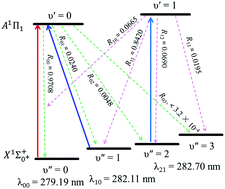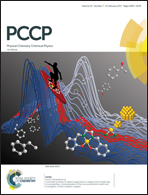Vibrational branching ratios and radiative lifetimes in the laser cooling of AlBr†
Abstract
The feasibility of laser cooling of the AlBr molecule is investigated using ab initio quantum chemistry. Potential energy curves, permanent dipole moments, and transition dipole moments for the ground state X1Σ+ and the first two excited states (a3Π and A1Π) are calculated using the multi-reference configuration interaction plus Davidson corrections (MRCI+Q) method with the ACVQZ basis set; the spin–orbit coupling effects are also taken into account in electronic structure calculations at the MRCI level. Based on the acquired potential energy curves and transition dipole moments, highly diagonally distributed Franck–Condon factors (f00 = 0.9540, f11 = 0.8172) and vibrational branching ratios (R00 = 0.9708, R11 = 0.8420) for the transition  are determined. Radiative lifetime calculations of the A1Π1 (ν′ = 0–4) state are found to be short (9.16–11.48 ns) enough for rapid laser cooling. The proposed main cycling laser drives the
are determined. Radiative lifetime calculations of the A1Π1 (ν′ = 0–4) state are found to be short (9.16–11.48 ns) enough for rapid laser cooling. The proposed main cycling laser drives the  transition at the wavelength λ00 = 279.19 nm. The vibrational branching loss ratios of the A1Π1 (ν′) state to the intervening states a3Π0+ and a3Π1 are small (<5.2 × 10−6) enough to be negligible. The present theoretical results indicate that the AlBr molecule is a promising candidate for laser cooling.
transition at the wavelength λ00 = 279.19 nm. The vibrational branching loss ratios of the A1Π1 (ν′) state to the intervening states a3Π0+ and a3Π1 are small (<5.2 × 10−6) enough to be negligible. The present theoretical results indicate that the AlBr molecule is a promising candidate for laser cooling.



 Please wait while we load your content...
Please wait while we load your content...